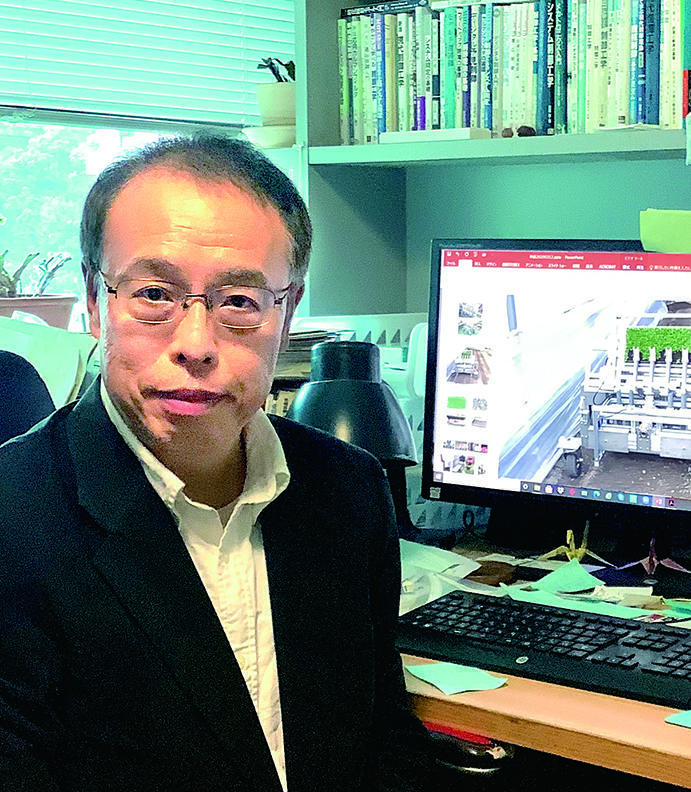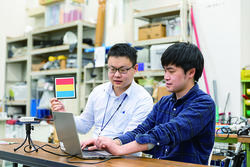- TOP
- Cutting-edge Research and Social Contribution
- Cutting-edge Research
- Development of human-like living support robots for appropriate daily living support based on physiological needs

Development of human-like living support robots for appropriate daily living support based on physiological needs

At the age of 25, Professor Shuoyu WANG came to Japan aspiring to do research on state-of-the-art robots. After taking a position at our university, he tackled the issue of the decreasing birthrate and aging population, developing "Human-Friendly Robotics" which work in cooperation with human beings. He developed and helped successfully commercialize the horse-riding fitness equipment "JOBA" (Panasonic) and the omni-directional training walker "ARUKING" (Soai) for supporting greater self-reliance of people with lower limb disabilities. In recent years, he has focused on refining previously developed technology, and designing robots to support the daily life of the bedridden elderly. He is establishing a highly advanced reasoning system, never seen before in the world, that recognizes a person's "physiological needs" and then acts accordingly by reasoning what best satisfies those needs.
Safety, simplicity, and integration of multiple functions into a single unit are keys to the spread of welfare robots
As society continues to age, the rising demand for nursing care and the shortage of caregivers have become pressing issues. While the development of support robots to lessen the burden of caregivers is flourishing, practical deployment in ordinary homes and facilities is lagging behind. Prof. Wang: "In addition to safety and simplicity of operation, integrating multiple functions into a single unit will be the key to greater dissemination of support robots in the future." He further points out that: "Most recently-developed support robots only have a single function. Robots with multiple functions such as cleaning and movement are needed by people with reduced physical function who require care, but having multiple robots in the home is not realistic due to cost and space."
The team led by Prof. Wang has developed a living support robot, integrating multiple functions into a single unit, which can carry out diverse types of tasks while the user is seated in a chair. This is achieved by maximally exploiting the upper body motor function of people with lower limb disability or elderly people with weak legs. A system was developed which uses motion sensors to detect the upper body movements of the user. The system thereby recognizes the operation intentions of the person, and carries out actions accordingly.
Prof. Wang's aim is to "allow users to live their lives as before by using this robot, so they can avoid becoming bedridden." At the same time, he has successfully developed safety control technology--a difficult problem in the field of support robots. As an accomplishment that will lead to the resolution of safety issues that have been a barrier to the widespread use of welfare robots, this work has received awards at international conferences and attracted worldwide attention.
Toward the world's first living support robot capable of providing the same support as caregivers
As an evolution of previous achievements, an integrated multi-functional robot which provides a range of living support services to bedridden elderly individuals has been developed. Alongside omniwheels enabling omnidirectional movement and arms with seven degrees of freedom to replicate human motions, various sensors are incorporated for environmental perception. Therefore, the robot can offer daily support for diverse tasks with human-friendly movements, while navigating home spaces freely through obstacle avoidance.
The biggest difference from existing living support robots is that, even without specific instructions, the robot can recognize abstract physiological needs like hunger or thirst, and provide the appropriate support. Major Japanese manufacturers have already developed cutting-edge robots capable of actions like fetching objects, and opening and shutting curtains, but clear instructions must be provided like "please make me some tea" or "please set the room temperature to 25°C."

"When dealing with bedridden elderly people whose brain function has declined, expressing physiological needs such as hunger or thirst is much simpler than giving specific instructions. A robot is more practical if it can understand physiological needs and take appropriate actions to satisfy them."
Speech recognition, device operation, and other previous methods of interaction with robots are very difficult for bedridden elderly people. Thus, Prof. Wang proposed the idea of using colored information on cards as a simpler, smoother communication technique. There is a high probability of misrecognition if only a single color is used, so a "colored AR marker" system was developed. This improves the AR markers that were the ordinary 2D recognition method, with recognition carried out in two stages based on a square shape and a trichromatic color pattern. On the front side of the cards, there are various color patterns, and on the back side there are text and illustrations indicating physiological needs like moving, eating, or excretion. A request is made by presenting the front side of the card to the robot. Color discrimination also has the advantage that processing speed is fast compared to complex image processing. The results of experiments conducted at a distance of 4 m from bed to robot showed that recognition was possible with a probability of roughly 90% or higher.
A reasoning system has been developed to bridge the gap between physiological needs and the appropriate support. When a physiological need is recognized, the system can reason to the appropriate object based on a pre-constructed knowledge base, and plan a series of actions to satisfy that need. For the robot to behave like a caregiver, it must understand how different objects can contribute to satisfying physiological needs, e.g., tea satisfies thirst. This information is consolidated in the knowledge base needed for reasoning. First, the objects that satisfy each of the basic physiological needs are identified. Then the contribution of each object is indicated on a scale from 0.0 to 1.0, e.g., for quenching thirst tea has a value of 0.8 and milk a value 0.4, while for satisfying hunger, bread has a value of 0.9 and milk has a value of 0.3. In addition, a knowledge base optimized for an individual can be constructed by including information like the types of furniture and appliances in the home environment, and their layout. Prof. Wang: "Optimizing for the individual is extremely important in the field of care--more important than versatility." Values suited to each person can also be entered into the knowledge base.
A robot with a reasoning system, incorporating a knowledge base optimized for a specific individual, can provide appropriate support while constantly updating its knowledge in reference to changes in the environment. Experiments have shown that, in addition to routine tasks like handing the person a biscuit from the table in response to hunger, the system also successfully addresses unforeseen situations. For example, when there is no biscuit at the usual location on the table, the system can select milk as another applicable item, take milk from the refrigerator, and hand it to the user. Additionally, if a biscuit is placed on a table different than usual, and the robot notices that, the position information of the biscuit will be updated. According to Prof. Wang, no one else in the world is researching robots that provide support by reasoning about human physiological needs, and many requests for joint research have come in from researchers overseas.
Prof. Wang's biggest goal is to develop robots that can provide the same support as human caregivers. "I want to make living support robots with extremely simple operation suited to real conditions, and high intelligence for reasoning to specific objects from physiological needs. I want the robots to be practical and inexpensive, and available in the near future."
Date of posting: March, 2024
